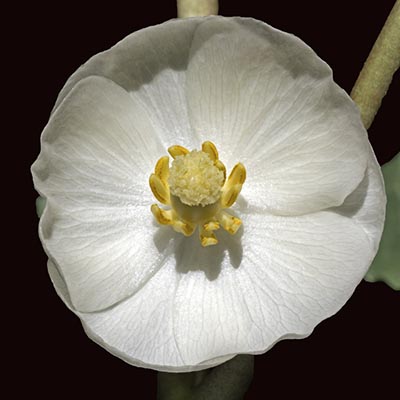 Hiking in the woods this spring, you may encounter a sight that may make you wonder "Did a convention of elves lose their umbrellas?" Those glossy green umbrellas popping up from the forest floor are mayapples, Podophyllum peltatum. They are found in the woodlands from western Quebec and Minnesota to Florida and Texas. Mayapples are found in clumps or colonies because the plant spreads by rhizomes. Rhizomes are stems that grow horizontally under the surface of the ground. From these stems, shoots and roots are produced.
Hiking in the woods this spring, you may encounter a sight that may make you wonder "Did a convention of elves lose their umbrellas?" Those glossy green umbrellas popping up from the forest floor are mayapples, Podophyllum peltatum. They are found in the woodlands from western Quebec and Minnesota to Florida and Texas. Mayapples are found in clumps or colonies because the plant spreads by rhizomes. Rhizomes are stems that grow horizontally under the surface of the ground. From these stems, shoots and roots are produced.
In the Barberry family, these plants are one of the easiest spring wildflowers to identify - having smooth dark green leaves that are wrapped around stems. The leaves are circular in shape with five to seven lobes. You can tell if a mayapple will produce a flower by looking at the number of leaves it has. One leaf, won't flower, two leaves will flower. It can take up to four years for a mayapple to mature and produce a flower.
The waxy white flower has six petals and is about 2" in diameter. The 2" long fruit is sphere to lemon-shaped. It will change in color from green to yellow as it ripens. The fruit of the mayapple is considered to be the only non-toxic part of the plant. Its fruit can be incorporated into marmalades, jellies, pies, and drinks.
Historically, Native Americans used the mayapple as a powerful laxative, to get rid of intestinal worms, as a wart cure-all, and as an insecticide on crops. They would gather the rhizomes in the fall, dry and then crush them into a powder. Care had to be taken because only certain parts of the rhizome are safe; the others can be quite toxic. Currently, the USDA lists mayapple as 'unsafe' and advises against using it medicinally at home. Modern science has discovered that extracts of mayapple can be used in the treatment of certain cancers and tumors.
From elfin umbrellas to cancer busters, mayapples have a myriad of uses. They are also one of the easiest spring wildflowers to be identified. On your next ramble into the woods, check under those leaves for the flower and fruit!
